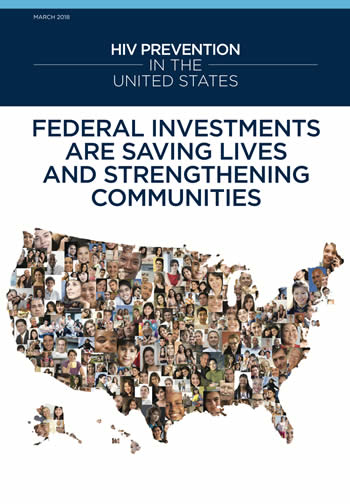
AIDSWatch 2018 is March 26 and 27. AIDSWatch is the nation’s largest annual constituent-based national HIV/AIDS advocacy event, bringing together hundreds of people living with HIV and their allies to meet with members of Congress and to educate them about the important issues at state for people living with HIV/AIDS in the United States.
In advance of AIDSWatch, Jeffrey S. Crowley and I released a new report, HIV Prevention in the United States: Federal Investments are Saving Lives and Strengthening Communities. The report details the history of HIV prevention in the US from the earliest years to today and identifies priority areas where more innovation is needed for forward progress in reducing HIV as a public health threat. Our goal is to tell the story of HIV prevention in a way that offers a compelling case for ongoing investments that will move us closer to ending the HIV epidemic.
Important progress has been made in reducing the size and scope of the HIV epidemic in the US, but the progress has been uneven with gay and bisexual men and transgender women, especially those who are Black and Latino/a, being disproportionately impacted. From 2008 to 2014, new HIV infections increased by 20% among Latino gay and bisexual men, and HIV rates rose for gay and bisexual men aged 25-34, even as rates fell in nearly all other groups. According to Centers for Disease Control and Prevention (CDC) data released yesterday estimating HIV incidence and prevalence in the US from 2010 to 2015, gay and bisexual men aged 25-34 and Latino gay and bisexual men saw a 32% increase and a 22% increase in new HIV infections respectively.
Federal investment in HIV prevention remains critically important. Our report states that federal investments must support continuing innovation to:
- Integrate surveillance and clinical care data systems;
- Interrupt HIV transmission within sexual and drug-using networks;
- Improve the tailoring and integration of services to the highest need communities;
- Develop long-acting prevention and therapeutic options; and
- Promote jurisdictional plans to end HIV as a public health threat.
The report is intended to be a resource for policymakers and HIV community stakeholders and to inform deliberations related to federal investment in HIV prevention. The O’Neill Institute’s Infectious Diseases Initiative continue to work with an array of policymakers and stakeholders, including federal agencies, state and local officials, and community members and advocates, to support effective HIV and hepatitis prevention, care, and treatment. In addition to this report, O’Neill Institute reports, policy briefs, and guides provide information, research, technical analysis, and recommendations so that policymakers and health officials can streamline policies and services to better support people living with and affected by HIV and so community stakeholders have the tools they need to advocate for investment and progress in efforts to end the HIV epidemic.



